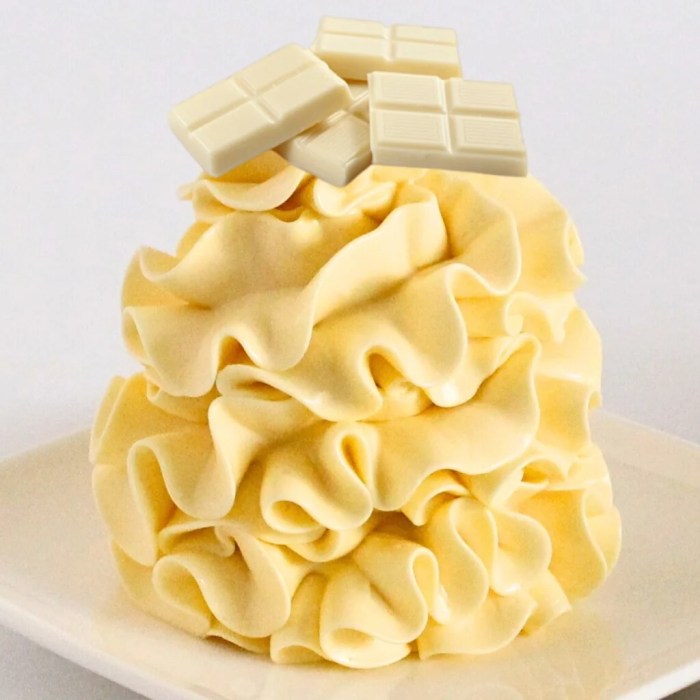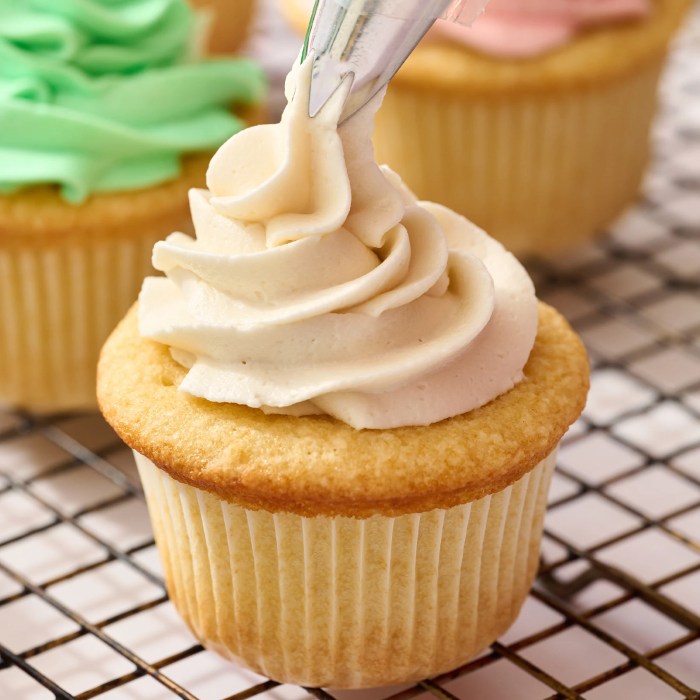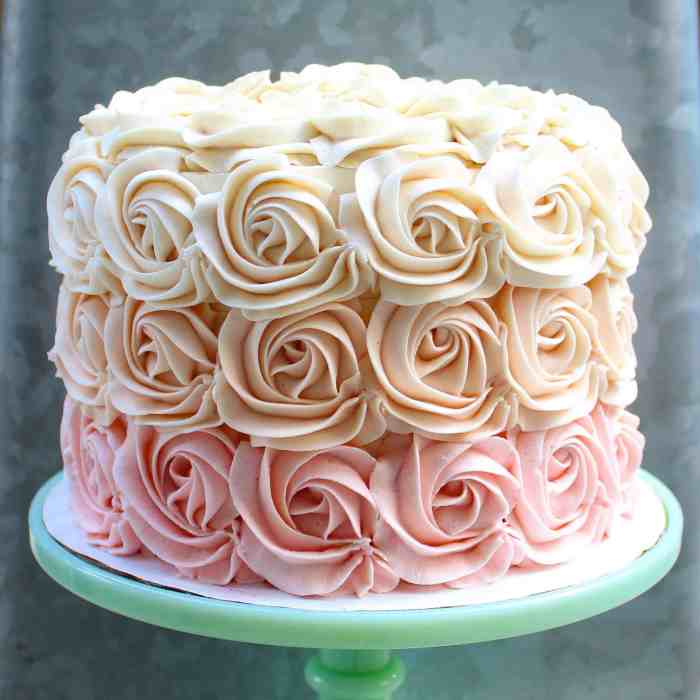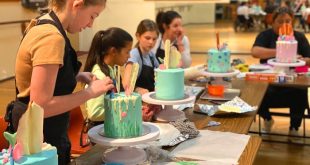Buttercream Frosting: A Baker’s Delight
Buttercream frosting for cake decorating – The world of cake decorating is a vast and wondrous landscape, a canvas upon which culinary artists paint their masterpieces. And at the heart of this artistry lies the humble, yet magnificent, buttercream frosting. A creamy, dreamy confection, it’s the glue that binds layers, the medium that transforms simple cakes into edible works of art. This exploration delves into the multifaceted world of buttercream, from its diverse types and techniques to its endless possibilities in flavor and design.
Types of Buttercream Frosting
Buttercream isn’t a monolithic entity; it’s a family of frostings, each with its unique personality and characteristics. Understanding these differences is key to selecting the perfect frosting for your cake creation. The four primary types – American, Swiss meringue, Italian meringue, and French buttercream – each boast a distinct texture, flavor profile, and stability.
| Type | Texture | Flavor | Stability |
|---|---|---|---|
| American Buttercream | Light and fluffy, can be quite soft | Buttery, sweet; flavorings easily incorporated | Less stable, prone to melting in warmer temperatures |
| Swiss Meringue Buttercream | Silky smooth, light, and airy | Rich, subtly sweet; more delicate flavor than American | More stable than American, holds its shape well |
| Italian Meringue Buttercream | Very smooth, glossy, and incredibly stable | Intensely rich and subtly sweet, often described as having a more luxurious taste | Most stable type, ideal for warm climates or intricate designs |
| French Buttercream | Rich and dense, heavier than other types | Intensely buttery flavor | Less stable than Swiss or Italian, best used on cakes kept cool |
The ingredients and their roles vary significantly across these types. American buttercream relies on simple butter, powdered sugar, and often milk or cream. Meringue-based buttercreams involve whipping egg whites with sugar to create a stable meringue base, which is then folded into butter. The method of heating the sugar – whether directly with the egg whites (Swiss) or by making a sugar syrup (Italian) – profoundly impacts the final texture and stability.
Achieving the desired consistency requires careful attention to technique. Over-mixing can lead to a grainy texture, while under-mixing results in a less stable product. The use of a stand mixer is often recommended, especially for meringue-based buttercreams, as it ensures even incorporation of ingredients and allows for consistent whipping.
Buttercream Frosting Recipes, Buttercream frosting for cake decorating
These recipes provide a starting point for your buttercream journey. Remember, experimentation is key to finding your perfect balance of flavors and textures.
American Buttercream Frosting
- 1 cup (2 sticks) unsalted butter, softened
- 3-4 cups powdered sugar
- 1/4 cup milk or cream
- 1 teaspoon vanilla extract
Tips: Beat butter until light and fluffy. Gradually add powdered sugar, alternating with milk, until smooth. Add vanilla extract. Adjust consistency with more milk or sugar.
Swiss Meringue Buttercream Frosting
- 1 cup egg whites
- 1 1/2 cups granulated sugar
- 2 cups (4 sticks) unsalted butter, softened
- 1 teaspoon vanilla extract
Tips: Whip egg whites and sugar over a double boiler until stiff peaks form. Beat in butter gradually until smooth and glossy. Add vanilla extract.
The smooth, creamy texture of buttercream frosting is a baker’s dream, perfect for creating intricate designs on cakes. This same artistry can be translated to the festive world of decorating christmas cookies , where a delicate swirl of buttercream can transform a simple cookie into a miniature masterpiece. Indeed, the versatility of buttercream knows no bounds, offering endless possibilities for both grand cakes and charming cookies alike.
Italian Meringue Buttercream Frosting
- 1 cup granulated sugar
- 1/2 cup water
- 1 cup egg whites
- 2 cups (4 sticks) unsalted butter, softened
- 1 teaspoon vanilla extract
Tips: Make a sugar syrup by combining sugar and water and heating to 240°F (115°C). Slowly pour the hot syrup into whipped egg whites, beating constantly until stiff and glossy. Beat in butter gradually until smooth and glossy. Add vanilla extract.
Unique Flavor Combination: Lavender Honey Buttercream
- Base: Use your favorite buttercream recipe (American or Swiss recommended)
- 1/4 cup honey
- 1 tablespoon dried culinary lavender
Infuse the honey with lavender by gently heating them together. Strain out the lavender before adding to the buttercream.
Cake Decorating Techniques with Buttercream

Source: cupcakesavvyskitchen.com
The artistry of buttercream lies not just in its taste, but in its ability to transform cakes into visual delights. From delicate rosettes to bold lettering, the possibilities are endless. A smooth crumb coat is crucial for a professional finish.
Piping techniques utilize various tips to create different effects:
- Rosettes: Wilton 1M, 2D tips create classic rosettes.
- Swirls: A variety of round tips (Wilton 1A, 2A) can create swirls.
- Borders: Small round tips (Wilton #2, #3) and star tips (Wilton 1M, 2D) are used for borders.
- Lettering: Script tips (Wilton #12, #230) or small round tips can be used for lettering. Practice is key!
Creating a crumb coat involves applying a thin layer of frosting to seal in the crumbs before applying the final layer. This prevents crumbs from showing through the final frosting.
Frosting a layered cake:
- Level the cake layers.
- Apply a crumb coat.
- Chill the cake for at least 30 minutes.
- Apply the final layer of frosting, smoothing it with a bench scraper or offset spatula.
- Decorate as desired.
Coloring and Flavoring Buttercream

Source: handletheheat.com
The palette of buttercream is as vast as the imagination. Gel food coloring provides intense color without altering the consistency. Liquid food coloring can thin the buttercream slightly. Natural food colorings, such as beet juice (red) or spinach (green), offer a unique approach but may require more experimentation.
Flavor pairings are endless: chocolate and raspberry, vanilla and strawberry, lemon and poppy seed. Extracts, spices (cinnamon, cardamom), and fruit purees add depth and complexity.
The delicate swirl of buttercream frosting, a testament to culinary artistry, can transform a simple cake into a masterpiece. This same creative spirit can be applied beyond the kitchen counter; consider extending your decorating prowess to the often-overlooked space above your cabinets, finding inspiration and ideas at decorating above kitchen cabinets. Just as a perfectly piped rose elevates a cake, thoughtful decor can lift the entire kitchen’s ambiance, inspiring you to return to your buttercream creations with renewed passion.
Troubleshooting Buttercream Frosting
Curdling, grainy texture, and overly stiff consistency are common pitfalls. Curdling often results from adding cold ingredients to warm butter. A grainy texture can be due to over-mixing or insufficiently softened butter. Overly stiff frosting can be remedied by adding a little milk or cream.
Proper storage is vital. Airtight containers in the refrigerator can help maintain quality and prevent separation. Bring the frosting to room temperature before use.
Buttercream Frosting for Different Cake Styles

Source: chelsweets.com
The style of cake dictates the appropriate buttercream application. A rustic naked cake might feature a minimal amount of frosting between layers, with a few decorative drips. A classic layer cake calls for a smooth, even frosting and potentially intricate piping. A modern minimalist cake might emphasize clean lines and geometric shapes created with buttercream.
The choice of buttercream type also matters. Italian meringue is ideal for intricate designs due to its stability, while American buttercream’s softer texture suits a more rustic aesthetic.
Textured surfaces can be created using various tools: a spatula for swirls, a fork for rustic patterns, or textured silicone mats pressed onto the frosted cake.
Tools and Equipment for Buttercream Frosting
Essential tools include a stand mixer (or hand mixer), bowls, spatulas (offset and bench scraper), piping bags, piping tips, and a cake turntable. The turntable facilitates even frosting and decorating.
- Stand mixer or hand mixer
- Mixing bowls
- Spatulas (offset and bench scraper)
- Piping bags (disposable or reusable)
- Assorted piping tips
- Cake turntable
- Measuring cups and spoons
Reusable piping bags are more economical but require cleaning. Disposable bags are convenient but generate waste. Tip selection depends on the desired decorating effect.
FAQ Resource: Buttercream Frosting For Cake Decorating
Can I make buttercream frosting ahead of time?
Yes, buttercream frosting can be made 1-2 days in advance. Store it in an airtight container in the refrigerator. Bring it to room temperature before using.
How do I prevent buttercream from becoming too stiff?
Add a teaspoon of milk or cream at a time until the desired consistency is reached. Overly stiff buttercream can be softened by adding a small amount of liquid.
What happens if my buttercream curdles?
Curdling usually indicates that the butter was too cold or that the ingredients were not properly incorporated. Try gently warming the butter and re-whisking the mixture until smooth.
How can I achieve a perfectly smooth finish on my cake?
Apply a thin crumb coat, chill the cake, then apply a final layer of frosting using a bench scraper or offset spatula for a smooth finish.
 Interior Living
Interior Living
